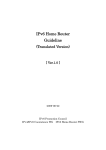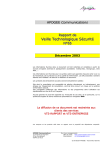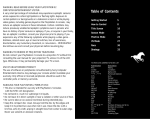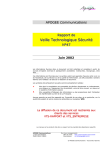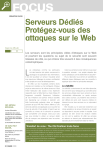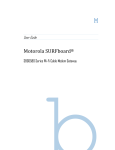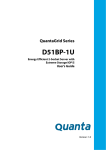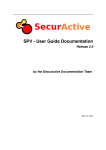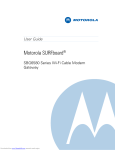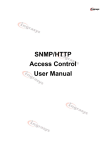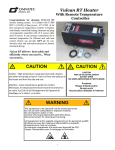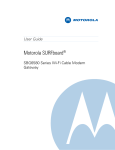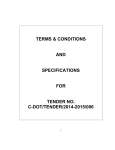Download IPv6 Home Router Guideline (Translated Version)
Transcript
IPv6 Home Router
Guideline
(Translated Version)
[ Ver.2.0 ]
7 - 29 - 2010
(Translated: 12 - 1 - 2012)
IPv6 Promotion Council
IPv4/IPv6 Coexistence WG IPv6 Home Router SWG
IPv6 Home Router Guideline 2.0 (Translated Version)
IPv6 Promotion Council
Table of contents
1
Introduction ................................................................................................................1
2
Connection Model for IPv6 Internet Service ..............................................................1
3
Address Assignment Function ...................................................................................2
3.1
Prefix Assignment ...................................................................................................2
3.1.1
3.1.2
3.2
3.2.1
Global Address Assignment Method (Automatic) ..........................................3
3.2.3
Response to the Absence of Global Address Assignment...............................4
3.3
Global Address Assignment Method (Manual) ..............................................3
LAN Side Address....................................................................................................4
3.3.1
Prefix Re-distribution ......................................................................................4
3.3.2
Multiple Prefix Reception ................................................................................4
3.3.4
Generation and Distribution of a ULA Prefix ................................................6
3.3.3
Change in Distributed Prefix ..........................................................................5
Security Function .......................................................................................................6
4.1
Access Control Function .........................................................................................6
4.1.1
Restriction of Access from Outside .................................................................6
4.1.3
Access Control of Fragmented Packets ........................................................10
4.1.2
4.1.4
4.2
5
Size of a Prefix Assigned to a Home Network ................................................2
WAN Side Address ...................................................................................................2
3.2.2
4
Prefix Information Distributed to a Home Network .....................................2
Functions Configurable for Access Control and their Level of Necessity ....9
Access Restriction to the Device itself ..........................................................10
Other security functions ....................................................................................... 11
DNS Proxy/Resolver Function..................................................................................12
5.1
Transport ................................................................................................................13
5.1.1
Transport protocol ..........................................................................................13
5.1.3
Prioritized Transport .....................................................................................13
5.1.2
Transport Conversion Function ....................................................................13
5.2
Type of Address on which DNS Proxy Listens ....................................................15
5.3
DNS Server selection ............................................................................................16
5.2.1
Type of Address on which DNS Proxy Listens .............................................15
5.3.1
Sequential Selection.......................................................................................16
i
IPv6 Home Router Guideline 2.0 (Translated Version)
5.3.2
Policy based Selection ....................................................................................16
5.4.1
Cache Function...............................................................................................17
5.5.1
Supported Resource Records .........................................................................18
5.5.3
EDNS0 ............................................................................................................18
5.4
Cache ......................................................................................................................17
5.5
Resolver Function ..................................................................................................18
5.5.2
5.5.4
5.5.5
6
Support of TCP Port 53..................................................................................19
DNSSEC .........................................................................................................19
Distributing Address/Prefix Information.............................................................20
6.1.1
6.1.2
6.2
6.2.2
6.3
Distribution Using RAs .................................................................................20
Distribution using DHCPv6 ..........................................................................22
Distributing Server Information ..........................................................................25
6.2.1
Distribution using RA ....................................................................................25
Distribution using DHCPv6 ..........................................................................25
Distribution of Other Information .......................................................................27
6.3.1
Distribution of MTU Information .................................................................27
Routing/Multicast Function .....................................................................................28
7.1
7.2
Communications to Unused Address/Network ...................................................28
Routing Information and Extension Header .......................................................29
7.2.1
WAN Side Routing .........................................................................................29
7.2.3
Extension Header ...........................................................................................32
7.2.2
7.3
LAN Side Routing ..........................................................................................30
IPv6 Multicast .......................................................................................................32
7.3.1
IPv6 multicast function .................................................................................32
7.3.2
Connection by PIM .........................................................................................33
7.3.4
MLD Snooping ................................................................................................34
7.3.3
7.4
8
Unexpected Flag and Data ............................................................................18
Information Distribution Function to Home Networks ...........................................20
6.1
7
IPv6 Promotion Council
Connection by MLD Proxy.............................................................................34
Special Forwarding ...............................................................................................36
Configuration Function for the Service Side............................................................37
8.1
Configuration Method ...........................................................................................37
8.1.1
8.1.2
Autoconfiguration...........................................................................................37
Manual Configuration ...................................................................................39
ii
IPv6 Home Router Guideline 2.0 (Translated Version)
8.2
Configuration Items ..............................................................................................40
8.2.1
Address Configuration ...................................................................................40
8.2.3
DNS Configuration ........................................................................................42
8.2.2
8.2.4
8.2.5
9
IPv6 Promotion Council
Security-related Configuration .....................................................................40
Home Network Configuration .......................................................................42
Routing/Multicast Configuration ..................................................................43
User Interface Function ...........................................................................................44
9.1
Web-GUI(Graphical User Interface) ...............................................................44
9.2
CLI(Command Line Interface) ........................................................................44
9.4
Text Representation of IPv6 Address/Prefix........................................................45
9.3
10
Entry of IPv6 Address/Prefix ................................................................................45
Conclusion .............................................................................................................46
10.1
10.2
Summary of Functions Required of IPv6 Home Router .....................................46
Study Items for Next Edition ...............................................................................52
10.2.1
10.3
10.4
Items Not Studied ..........................................................................................52
Study Members ......................................................................................................53
Reference List ........................................................................................................54
iii
IPv6 Home Router Guideline 2.0 (Translated Version)
IPv6 Promotion Council
1 Introduction
This section is not translated to English.
2 Connection Model for IPv6 Internet Service
This section is not translated to English.
1
IPv6 Home Router Guideline 2.0 (Translated Version)
IPv6 Promotion Council
3 Address Assignment Function
This chapter describes methods for assigning addresses to a terminal to be connected
to the WAN side, LAN side, and LAN side segments of a router.
3.1
Prefix Assignment
This section describes requirements for a router when a service provider assigns a
prefix to a user.
3.1.1 Prefix Information Distributed to a Home Network
Requirement 1:
A router can get prefix information for home network from
the connected service provider using DHCPv6-PD.
Necessity:Mandatory(MUST)
Reason:DHCPv6-PD is the standard protocol for automatic prefix assignment. It
eliminates wrong configuration due to manual inputting by a user.
Requirement 2:
configured.
Prefix information for home network can be manually
Necessity:Mandatory(MUST)
Reason: The connected service provider may not support prefix distribution using
DHCPv6-PD.
3.1.2 Size of a Prefix Assigned to a Home Network
Requirement 3:
A router can receive the prefix assigned by a service provider
in the range of /48 - /64.
Necessity:Mandatory(MUST)
Reason:It is required that a prefix in the range of /48 - /64 is assigned to an end site
by “IPv6 Address Allocation and Assignment Policy at JPNIC”[8].
Remarks:As it is conceivable that segments are separated between wireless and
wired or deployment of DMZ, distribution of multiple segments (prefix length
shorter than /64) is desirable. The assigned prefix size, however, is to be
decided by a service provider.
Though the prefix length may be shorter than /48 in enterprise network,
enterprise network is out of the scope in this section.
3.2
WAN Side Address
This section describes address assignment to the WAN side of a Home Router (link
2
IPv6 Home Router Guideline 2.0 (Translated Version)
IPv6 Promotion Council
with service provider) in a service model described in Section 1.4.3.1.
3.2.1 Global Address Assignment Method (Automatic)
Requirement 4:
side interface.
A global address can be assigned automatically to the WAN
Necessity:Mandatory(MUST)
Reason:This is mandatory for realizing automatic setting without user intervention.
Both of the following methods are mandatory.
[a] SLAAC(Stateless Address Auto configuration)
[b] DHCPv6
Remarks:It depends on a service provider which method — SLAAC or DHCPv6 —
is used in assigning an IP address. To support both services, a router has to
implement both functions.
It is also considered possible to have it automatically determined whether
SLAAC or DHCPv6 is used without letting a user configure this [59].
If SLAAC is used, a service provider cannot know the assigned address unless
it is used in combination with a mechanism for informing the provider of the
assigned address (DDNS etc.).
The following elements also need to be taken into account in selecting the
function.
•
Technical trends: as of July 2010, with DHCPv6, prefix length distribution
needs to be used in combination with a router advertisement/prefix option
etc.
•
The fact that, for an IPv6 global unicast address, the interface identifier is
•
The requirements concerning address prefix size to be assigned to WAN
specified as 64-bit length [46].
side and problems that can arise in this regard (Section 7.1).
3.2.2 Global Address Assignment Method (Manual)
Requirement 5:
interface.
A global address can be assigned manually to the WAN side
Necessity:Mandatory(MUST)
Reason:Although automatic configuration is presumed, manual configuration is
also necessary.
3
IPv6 Home Router Guideline 2.0 (Translated Version)
IPv6 Promotion Council
3.2.3 Response to the Absence of Global Address Assignment
Requirement 6:
A router can communicate using an address in assigned prefix
range to LAN side network if no address is assigned to WAN side interface.
Necessity:Mandatory(MUST)
Reason:This is mandatory as a router is required to send and receive packets under
a service model in which a global address is not assigned to the WAN side.
Remarks:This function is necessary when a router acts as a DNS proxy, etc.
Using a LAN side address or assigning an address to a virtual interface is
conceivable, but this document does not specify how to generate an address to
be used.
3.3
LAN Side Address
This section describes address assignment to the LAN side of a Home Router (link
with user’s home network).
3.3.1 Prefix Re-distribution
Requirement 7:
On the basis of a prefix received using DHCPv6-PD from a
service provider, a router can generate a /64 prefix and re-distribute it to the
LAN side.
Necessity:Mandatory(MUST)
Reason:This is mandatory as a means for automatically redistributing a prefix
distributed to user’s home network by a service provider to user's home
equipment.
Remarks:With regard to the protocol for redistribution, see Section 6.1.
The method is not specified for deriving a /64 prefix from a prefix larger than
/64 received using DHCPv6-PD. For example, if a /48 prefix has been received
using DHCPv6-PD, it is necessary to determine the values in the range of 49 to
64 bits when redistributing it to the LAN side. The method for determining
those values is not specified in this document.
3.3.2 Multiple Prefix Reception
A router can select which prefix is to be redistributed to the LAN side if multiple
prefixes have been received using DHCPv6-PD from one or more service providers.
Necessity:Optional(MAY)
Reason:This requirement is intended to support environments where multiple
upstream service providers exist or where the service provider distribute
4
IPv6 Home Router Guideline 2.0 (Translated Version)
IPv6 Promotion Council
different multiple prefixes. Because an environment with a number of
upstream service providers is considered to be exceptional for a Home Router,
this should be treated as optional.
Remarks:A connection service is conceivable which distributes one fixed prefix and
one unfixed prefix.
Since fixed and unfixed prefixes each have its own advantages, it is preferable
for a user to be able to select either.
An attention should be paid to a conceivable case in which the choice of one
type of prefix precludes an access to a specific network.
If multiple prefixes are assigned by multiple service providers, a problem can
arise with terminal’s behavior [17].
3.3.3 Change in Distributed Prefix
Requirement 8:
If the prefix distributed using DHCPv6-PD by the service
provider changes due to WAN side reconnection or other reasons, a router can
properly change the prefix to be distributed to the LAN side.
Necessity:Mandatory(MUST)
Reason:It is necessary to minimize such impacts on communication in a user’s
network as resulting from the use of a service which varies a prefix assigned to
a user with time.
Remarks:This document does not specify a method for changing an assigned prefix.
See Section 6.1.2 for renumbering terminals in a home network upon a change
in the distributed prefix.
5
IPv6 Home Router Guideline 2.0 (Translated Version)
IPv6 Promotion Council
3.3.4 Generation and Distribution of a ULA Prefix
Requirement 9:
A router can generate a ULA prefix and distribute it to the
LAN side if prefix information is not assigned by the service provider.
Necessity:Recommended(SHOULD)
Reason:This is to guarantee communication in the home network when a global
address is not assigned in IPv6-only environment. It is classified as
Recommended (Not Mandatory), since home networks are usually expected to
be dual stack.
Remarks:Specifications of ULA should be based on RFC4193.
In the reference [59], the use of ULA is Mandatory (MUST).
Renumbering is required if prefix information is assigned by the service
provider after the distribution of a ULA prefix.
4
Security Function
This chapter describes security functions that are considered to be minimally
necessary for the protection of a user’s home network. Functions dealt with here are
minimally necessary elements for realizing integrity (prevention and detection of data
tampering, recovery of tampered data, etc.), confidentiality (encryption, etc.), and
availability (convenience in configuration, etc.). While enhancing users’ awareness of
security, it is necessary to take a flexible approach by combining these elements
[60][61].
4.1
Access Control Function
4.1.1 Restriction of Access from Outside
As a prerequisite, security functions employed for IPv4 (including direct
non-reachability from an outside network to a home network owing to NAT/NAPT) are
also necessary for an IPv6 Home Router.
6
IPv6 Home Router Guideline 2.0 (Translated Version)
4.1.1.1
IPv6 Promotion Council
Basic Setting for Access Restriction
Figure 4-1 Function of Access Control from Outside
Requirement 10:
A router
can
perform
access restriction
that allows
communication from inside (LAN side) to outside (WAN side) and blocks
communication from outside to inside.
Necessity:Mandatory(MUST)
Reason:Access control equivalent to the initial behavior of the current IPv4 Home
Router is necessary.
Remarks:Although the default behavior blocks communication from outside to
inside, it is also necessary to enable a setting that allows such communication
(see also Section 4.1.2.).
4.1.1.2
Access Restriction by Static Filter
Requirement 11:
A router can restrict access by static filter.
Traffic is passed through by default from inside to outside.
With UDP, communication from outside to inside is blocked by default.
With TCP, SYN from outside to inside is dropped by default.
Note: The mandatory protocols for services, such as DNS, telephony, TV, etc.
need to be allowed.
With ICMPv6, only mandatory messages [9] from outside to inside are passed
through, while others are blocked by default.
7
IPv6 Home Router Guideline 2.0 (Translated Version)
IPv6 Promotion Council
Necessity:Mandatory(MUST)
Reason:To maintain the minimally necessary level of network security achieved in
current IPv4 networks by NAT restriction in IPv6 network.
Remarks:Whether an IPv6 address on a WAN side interface should be configured or
not should be determined in light of its necessity in service provision and
security.
In implementing access control, it is necessary to take reassembling of
fragmented packets into account. (See Section 4.1.3 also.)
Even a traffic from inside is recommended to be blocked if its source address is
any of the following.
・Global address other than one assigned by the service provider
・Link-local address(fe80::/10)
・Site-local address(fec0::/10, deprecated in RFC3879)
・ULA(fc00::/7)
・Multicast address(ff00::/8)
・Well-known anycast address
Subnet-router anycast address, etc.
・IANA reserved address(::/8)
loopback address, unspecified address, IPv4-compatible address,
IPv4-mapped address, etc.
・Documentation address(2001:db8::/32)
4.1.1.3
Access Restriction by Dynamic Filter (Stateful Packet Inspection:
SPI)
Requirement 12:
A router can restrict access by a dynamic filter (SPI).
Traffic is passed through by default from inside to outside.
Connections from inside to outside are recorded, and returned traffic of this
connection from outside to inside is passed.
Necessity:Recommended(SHOULD)
Reason:This is intended to maintain a security level equivalent to the current IPv4
NAT in IPv6 as well. It is, however, classified as recommended as a static filer
can ensure the minimally necessary level of security.
It is classified as Recommended also because it is an important function for
maintaining the security level in IPv6.
As regards SPI, see the descriptions in RFC 4787 also [47].
Such implementation of SPI state control is classified as Recommended that
8
IPv6 Home Router Guideline 2.0 (Translated Version)
IPv6 Promotion Council
takes into account control using a timer.
4.1.2 Functions Configurable for Access Control and their Level
of Necessity
Requirement 13:
Table 4-1.
A router can configure access control functions indicated in
Necessity:Mandatory(MUST)
Table 4-1
Functions Configurable for Access Control and their Level of Necessity
Function
A router can control access by IPv6 source/destination address.
Necessity
Mandatory
(MUST)
A router can recognize the next header (protocol).
(See Section 7.2.3)
Mandatory
(MUST)
A router can control access by protocol type.
(Extended header type etc.)
Recommended
(SHOULD)
A router can trace the next header chain.
Mandatory
(MUST)
A router can control access by ICMP Type and Code [9].
Recommended
(SHOULD)
A router can control access by TCP/UDP source/destination port
number.
Mandatory
(MUST)
Reason:To maintain the security level of the current IPv4 network in IPv6 as well
[10].
Remarks:This document does not specify the degree of depth to which the next
header chain needs to be traced.
In realizing a communication using a tunnel, it is required to consider the
implementation of access control corresponding to addresses inside a tunnel
such as DPI (Deep Packet Inspection).
9
IPv6 Home Router Guideline 2.0 (Translated Version)
IPv6 Promotion Council
4.1.3 Access Control of Fragmented Packets
Requirement 14:
A router can reassemble fragmented packets and control their
access based on the settings for control of access from outside.
Necessity:Optional (MAY)
Reason : This is required because access control needs to be performed for
fragmented
packets.
Since,
however,
reassembling
and
maintaining
fragmented packets consume equipment resources, this is classified as
Optional.
Remarks:A UDP packet is often used for DNS communication, and the size of
UDP packet is expected to increase due to an increase in the size of DNS
response packet caused by the spread of DNSSEC and other reasons. If the
size of a packet exceeds the path MTU size, the original packet is fragmented
and sent as fragmented packets. In this case, unfragmentable parts of the
original packet are included in every fragmented packet, but fragmentable
parts exist only in the fragmented packet into which they are divided.
Therefore, under the condition that this function is not implemented, if the
upper layer protocol header, etc. exist only in fragmentable parts, access
control is possible only for a leading packet of a fragment and impossible for
other fragmented packets.
4.1.4 Access Restriction to the Device itself
Requirement 15:
Access control is possible with communications to the device
itself. Access control is likewise possible with functions controlling the device
itself.
Necessity:Mandatory(MUST)
Reason:Because it is necessary to ensure security for service functions provided by
the device itself as an IPv6 host.
10
IPv6 Home Router Guideline 2.0 (Translated Version)
4.2
IPv6 Promotion Council
Other security functions
Requirement 16:
A router is equipped with such security functions as warning
against configuration changes.
It has a safe initial configuration for protecting itself from internal and
external security risks and gives warning if such a change in configuration is
made as is vulnerable.
It is equipped with anti-virus and anti-tampering functions.
It has safe initial configuration for communication transiting it.
It has functions for logging, notifying, disaster recovery, etc.
It can warn against and notify a change entailing security risk.
It can be configured for address conversion, etc.
If wireless LAN is to be used, a router is required to have a strong encryption
function.
Necessity:Optional(MAY)
Reason:This requirement is intended to inform a user unfamiliar with security of
safety and risk of a given configuration as well as to support such a user. This
is classified as Optional, however, since functions given here are wide ranging,
which makes it difficult to define the minimum functions required.
11
IPv6 Home Router Guideline 2.0 (Translated Version)
IPv6 Promotion Council
5 DNS Proxy/Resolver Function
This chapter describes the DNS Proxy function and other DNS-related functions such
as Resolver function that is implemented in many current IPv4 Home Routers. Also see
[14].
Figure 5-1 Conceptual Diagram for DNS Proxy/Resolver Function
Although opinions are divided as to the necessity of DNS Proxy/Resolver function for
a home router, cache can mitigate the load of DNS server if it is implemented in home
router.
In addition, if it is not implemented, there is a possibility that problems such as a
delay or communication failure arise due to incorrect selection of DNS server at the
terminal side. Furthermore, the direct input of IP address, instead of FQDN, will then
be necessary for access to a router’s Web-GUI. Since the direct input of IPv6 address is
difficult, this will degrade users’ convenience.
http://setup.example.jp/ → http://[2001:db8:1234:5678::1]/
This guideline summarizes requirements for implementing DNS Proxy/Resolver
functions under the following preconditions.
Queries from a terminal and responses from DNS server are handled as
Cases
transparently as possible without changing a flag or data.
involving
a
conversion
process
such
as
translator
or
ALG
(application-level gateway) are not discussed in this document since the
function in question will then be included in the functions of translator or ALG.
Since there is a risk that a terminal receives an unintended response if such a
conversion process is involved, an individual case needs to be examined.
DNS Resolver functions are described to be considered regardless of IPv4 or
12
IPv6 Home Router Guideline 2.0 (Translated Version)
IPv6 Promotion Council
IPv6.
5.1
Transport
Figure 5-2 Selection of Transport Used
5.1.1 Transport protocol
Requirement 17:
Both IPv6 transport and IPv4 transport are supported as
transport over which a query to a DNS server is made.
Necessity:Mandatory(MUST)
Reason:To be able to support both cases when the DNS server address specified by
the service provider may be either IPv4 or IPv6.
5.1.2 Transport Conversion Function
Requirement 18:
A router can convert a query from the terminal in whatever
transport to a one in transport required by the service provider.
Necessity:Mandatory(MUST)
Reason : Because capability for DNS communication is required even in the
transition period to IPv6.
5.1.3 Prioritized Transport
Requirement 19:
If a query from the terminal is made over the same transport
as the one used by the DNS server designated by the service provider, a proxy
action is performed over the same transport as the one over which a query from
the terminal is made.
Necessity:Optional(MAY)
Reason:If the transport is not changed, it is more likely that the requesting
terminal obtains the expected result [15]. This requirement is Optional, since
13
IPv6 Home Router Guideline 2.0 (Translated Version)
IPv6 Promotion Council
there is no guarantee that the DNS server beyond the home router (DNS
proxy) uses the same transport.
Remarks:If the DNS server supports only IPv4 transport even though a query from
the terminal to the DNS Proxy is made over IPv6 transport, the DNS Proxy
needs a transport conversion function. Unless the terminal chooses transport
intentionally, it is meaningless for the DNS Proxy to use the same transport.
When a proxy action is performed over the same transport, the DNS Proxy
needs a function to record the transport over which the terminal has made a
query.
As some DNS servers in the IPv4 Internet are configured to give different
responses based on the source address, using the same transport does not
necessarily result in the same response. Using the same transport, however,
makes it more likely that a more appropriate response is obtained. In addition,
the terminal may make a transport specific query. Using the same transport is
thus more likely to result in a more appropriate response.
The necessity for this requirement will be reexamined when a need arises in
the future to use the same transport.
14
IPv6 Home Router Guideline 2.0 (Translated Version)
5.2
IPv6 Promotion Council
Type of Address on which DNS Proxy Listens
Figure 5-3 Type of Address Listened On
5.2.1 Type of Address on which DNS Proxy Listens
Requirement 20:
A router can listen on a unicast address (any of global address,
ULA, or link-local address).
Necessity:Mandatory(MUST)
Reason:Because it is necessary to be able to listen on a unicast address at least.
Remarks:ULAs need to be defined in advance for the DNS Proxy if it listens on
ULAs. It should be noted that, if a ULA has been already used on the LAN, a
mechanism is required to generate a different ULA that does not conflict with
it.
When the DNS Proxy listen on a global address in case upstream connection is
dropped or where setup is incomplete, it is conceivable that there is no global
address assigned to the DNS Proxy. Such a case should be paid attention to,
because a query packet does not reach the DNS Proxy. Some additional
considerations are also required including not to accept queries from the WAN
side in order not to become a DNS Open Resolver which is used in a DNS
amplification attack.
When the DNS Proxy listens on a link local address, queries from other
segments do not reach the DNS Proxy. Attention also needs to be paid for a
possibility that some hosts don’t accept link-local address as a DNS server’s
address.
15
IPv6 Home Router Guideline 2.0 (Translated Version)
5.3
IPv6 Promotion Council
DNS Server selection
Figure 5-4 DNS Server Selection
5.3.1 Sequential Selection
Requirement 21:
sequentially.
A router can handle a list of DNS servers and select one
Necessity:Mandatory(MUST)
Reason:To increase reachability to the destination.
5.3.2 Policy based Selection
Requirement 22:
A router can handle a policy based on a domain name, and
select a DNS server according to a domain name specified by a user’s query.
Necessity:Optional(MAY)
Reason:With this function, service providers such as access providers can provide
policy based on domain name. It is classified as Optional, however, since this
function largely depends on service provided by service providers.
Remarks:Although both sequential selection mechanism and domain name based
selection mechanism can be a solution for the DNS server selection issue for
each service network in a multi-prefix environment, both mechanisms should
be based on the consideration of their advantages and disadvantages since
neither of them provides an almighty solution [17].
There is no standard that prioritizes DNS query transports (IPv6 or IPv4).
Some argue that IPv4 should be used because there is concern about the
16
IPv6 Home Router Guideline 2.0 (Translated Version)
IPv6 Promotion Council
stability of current IPv6 DNS servers, while others argue that IPv6 should be
used considering migration to IPv6 in the near future. Currently this issue is
under discussion. At this moment, resolvers of many operating systems favor
IPv6 transport. It is assumed that the same result should be returned from the
DNS server regardless of transport. [16]
5.4
Cache
Figure 5-5 DNS Cache Function
5.4.1 Cache Function
Requirement 23:
The responses returned to a query from the terminal should
be cached, and the cached information should be returned upon subsequent and
similar queries.
Necessity:Optional(MAY)
Reason:This is required because it enables the load mitigation (suppression of
query/response packets) of the service provider’s DNS server. It is Optional,
however, as there are many things to be considered in its implementation.
Remarks:As a prompt action is required if a DNS-related vulnerability such as a
Kaminsky Attack [18] is found, the implementation of this function needs to be
based on the consideration of its advantages and disadvantages.
It should be noted that caching large records such as RRSIG is required to
support DNSSEC.
17
IPv6 Home Router Guideline 2.0 (Translated Version)
5.5
IPv6 Promotion Council
Resolver Function
Although the following functions required of a DNS resolver are not IPv6-specific,
they are more relevant to IPv6 than to IPv4. They are hence recommended to be
considered as a part of the specifications to be implemented in a Home Router.
Figure 5-6 DNS Resolver Function
5.5.1 Supported Resource Records
Requirement 24:
Queries from a host should all be processed transparently
regardless of resource record (RR) type.
Necessity:Mandatory(MUST)
Reason:Because the requesting host cannot get the expected result if RR type is
limited.
Remarks:A reverse query for a ULA must not be made, however (except when a
ULA is used within a service provider).
5.5.2
Unexpected Flag and Data
Requirement 25:
Received flags and data that cannot be interpreted must not
be changed or deleted.
Necessity:Mandatory(MUST)
Reason:To maintain transparency between a terminal and the DNS server.
5.5.3 EDNS0
Requirement 26:
A router can process EDNS0-compliant [19] query packets
18
IPv6 Home Router Guideline 2.0 (Translated Version)
IPv6 Promotion Council
(including OPT RRs) transparently and send a response exceeding 512 bytes to a
terminal. In addition, a router must forward fragmented response packets
without modification or after reassembling them.
Necessity:Mandatory(MUST)
Reason:Because situations in which a DNS reply packet exceeds 512 bytes are
arising, due to use of AAAA or PTR, SPF, SRV, TXT, DNSSEC etc.
5.5.4 Support of TCP Port 53
Requirement 27:
A query can be processed transparently even if the terminal
(after receiving DNS Header TC=1 [20], [21]) falls back to TCP connection. (A
router must listen not only on UDP Port 53 but also TCP Port 53.)
Necessity:Mandatory(MUST)
Reason: In order not to influence the query-related behaviors of a terminal.
5.5.5 DNSSEC
Requirement 28:
A
router
transparently [22][23][24].
can
process
packets
supporting
DNSSEC
EDNS0 (OPT RR) DO bit set.
RRSIG, DNSKEY, DS, NSEC, NSEC3, NSEC3PARAM RR used.
For DNS Header Bit, CD (checking disabled) or AD (authentic data) is used.
Necessity:Mandatory(MUST)
Reason:In order not to influence the query-related behaviors of a terminal.
Requirement 29:
DNSSEC-compliant
recursive
processing
(validator)
including signature verification is implemented as a DNS Proxy/Resolver
function [22][23][24].
Necessity:Optional(MAY)
Reason : This requirement is intended to process queries from a terminal
appropriately. It is classified as Optional, however, since realization is possible
as a single function Proxy with an IP address conversion function only.
Remarks: This needs to be considered as Windows 7 supports DNSSEC although it is
currently not implemented in Windows XP or Windows Vista.
It depends on implementation whether to implement recursive processing
(validator) including signature verification as a Home Router’s DNS
Proxy/Resolver function or to operate as a single function Proxy with an IP
address conversion function only.
19
IPv6 Home Router Guideline 2.0 (Translated Version)
IPv6 Promotion Council
6 Information Distribution Function to Home Networks
This chapter describes the distribution function of address/prefix information and
server information from the Home Router to hosts.
6.1
Distributing Address/Prefix Information
6.1.1 Distribution Using RAs
Requirement 60: A router has a function to inform a host of the prefix to be assigned
to it through router advertisement (RA).
Necessity:Mandatory(MUST)
Reason:This function is mandatory for an IPv6 router [28].
Remarks:See Section 3.3.2 about the policy for prefix information distribution
within LAN upon obtaining multiple prefixes from service providers.
Router Advertisement
2001:db8:1:1::/64
Figure 6-1 Distribution of Prefix Information Using RA
Requirement 61: The length of a prefix notified by RA should be /64 by default.
Necessity:Mandatory(MUST)
Reason:Many implementations use the last 64 bits of an address as the interface ID
in stateless address auto configuration.
Remarks:It should be noted that, when a prefix whose length other than /64 is
distributed, the address for a device in a LAN sometimes may not be set
correctly. For example, in Windows Vista SP1, an address cannot be generated
from a prefix other than /64 .
According to SLAAC (RFC 4862) specifications, if the sum of the prefix length
in the Prefix Information Option of RA and the length of an interface ID that a
20
IPv6 Home Router Guideline 2.0 (Translated Version)
IPv6 Promotion Council
terminal itself has does not equal 128 bits, the Prefix Information Option
MUST be ignored [29][48]
Requirement 62: A router has a function to send an RA such that Preferred Lifetime
in its Prefix Information option is set to 0.
Necessity:Recommended(SHOULD)
Reason:This is a function required to minimizing the impact on communication by a
terminal in such cases as switching the service provider. The requirement
should be classified as Recommended, however, since this function needs to be
implemented by taking into account occasions on which it is performed.
Remarks:If an address A whose Preferred Lifetime is 0 and an address B whose
Preferred Lifetime is not 0 are assigned to a terminal, the address B is
preferred as a source address for a communication initiated by the terminal
[15].
One conceivable occasion on which this function is performed is, for instance,
when a change in a prefix assigned by the service provider is detected due to
service provider switching or other reasons. In this case, if a RA is sent which
has a preferred lifetime field set to 0 for the old prefix, a terminal which
receives the RA ceases to use an address which has the old prefix in
subsequent communications, enabling a smooth change in (renumbering of)
the address of a home terminal. If an RA which has a preferred lifetime field
set to 0 for the old prefix is not sent, it is possible that an address generated
from the old prefix is used as a source address for communication initiated
until the preferred lifetime for the old prefix is changed to 0 at the terminal,
which may conceivably cause a problem in communication.
Another occasion conceivable is when a disconnection is detected in the WAN
side link. (Since reachability is then lost to a global prefix assigned to a home
network, that prefix becomes invalid.) In this case, however, it is possible that
home network communication beyond a router, in particular, is disabled at the
point of time when a global address inside the home network becomes invalid
(when valid lifetime becomes 0). Consequently, such measures are required to
be taken as ensuring communication in a home network by advertising a ULA
prefix. (See Section 3.3.4.)
Requirement 63: A router has a function to send an RA with Router Lifetime set to 0.
21
IPv6 Home Router Guideline 2.0 (Translated Version)
IPv6 Promotion Council
Necessity:Recommended(SHOULD)
Reason:This is effective when a terminal is not preferred to select itself as the
default route. This requirement is classified as Recommended, however, since
this function needs to be implemented by taking into account occasions on
which it is performed.
Remarks:A terminal receiving an RA with Router Lifetime set to 0 does not select
the router sending the RA as the default route.
One conceivable occasion on which this function is performed is, for instance,
when a disconnection is detected in the WAN side link. In this instance, if an
RA with Router Lifetime set to 0 is sent, the terminal receiving it ceases to
select the router sending the RA as the default route. The terminal,
consequently, will no longer send such packets to the router that are bound for
any destination other than the LAN segment it belongs to (Internet-bound
packets).
Attention should be paid to a case where multiple LAN segments are
connected to a router. Since, in this case, sending only an RA with Router
Lifetime set to 0 disables communication from one LAN segment to another
LAN
segment,
such
countermeasures
more-specific routes [35] are required.
as
route
distribution
through
6.1.2 Distribution using DHCPv6
Requirement 64: A router has a function to inform hosts of an address by
DHCPv6.[27]
Necessity:Optional(MAY)
Reason:It is effective when assigning a specific address to a home network terminal.
This requirement is Optional, however, as SLAAC is generally used for
address configuration on the terminal side.
Remarks:If this function is enabled, advertise an RA with M flag set to 1 to a LAN
segment.
22
IPv6 Home Router Guideline 2.0 (Translated Version)
IPv6 Promotion Council
DHCPv6
2001:db8:1:1::aaaa/64
DHCPv6
2001:db8:1:1::bbbb/64
Figure 6-2 Distribution of Address Information by DHCPv6
23
IPv6 Home Router Guideline 2.0 (Translated Version)
IPv6 Promotion Council
Requirement 65: A router has a function to send a Reconfigure message with the
msg-type of its Reconfigure Message Option set to 5 (Renew message).
Prerequisite:Requirement 35 has been implemented.
Necessity:Recommended(SHOULD)
Reason:This is effective for prompting a terminal to reacquire an address quickly
via DHCPv6 when its address is changed. This requirement is classified as
Recommended, however, since this function needs to be implemented by taking
into account occasions on which it is performed.
Remarks:One conceivable occasion which this function is performed is, when a
change in the prefix assigned by the service provider is detected due to service
provider switching or other reasons.
Requirement 66: A router has a function for distributing a prefix to another router in
a home via DHCPv6-PD[30] and a function that can specify, for the router in a home,
the prefix to be distributed.
Necessity:Optional(MAY)
Reason:This is effective for distributing the prefix to be assigned to the terminal
connected to the relevant router when multiple routers exist in a home
network. This requirement is classified as Optional
since there are
conceivably not so many users who install multiple routers in their home
network.
Figure 6-3 Distribution of Prefix Information by DHCPv6-PD
24
IPv6 Home Router Guideline 2.0 (Translated Version)
6.2
IPv6 Promotion Council
Distributing Server Information
6.2.1 Distribution using RA
Requirement 67: A router has a function for distributing a DNS server address to a
LAN segment RA.
Necessity:Optional(MAY)
Reason:Implementation is expected at a terminal [31] for obtaining a DNS server
information from RA (as DNS information distribution through RA is going
through standards track [31]). This requirement is classified as Optional,
however, since this function is currently not standardly implemented in
Windows XP/Vista/7 or MacOS.
Remarks:If the DNS server address is changed due to service provider switching or
other reasons, it is preferable to advertise an RA message with RDNSS
option’s Lifetime field set to 0 for the old DNS server address in order to have
the old DNS server address deleted from the DNS server list that a terminal
has.
Router Advertisement
2001:db8:1:1::/64
- 2001:db8:1:1::53/64
Sample Server Addresses
DNS
2001:db8:1:1::53/64
Figure 6-4 Distribution of Server Information by RA
6.2.2 Distribution using DHCPv6
Requirement 68: A router has a function for distributing DNS server address to a
LAN segment DHCPv6 .
Necessity:Mandatory(MUST)
Reason:DHCPv6 is commonly used as the method to obtain DNS server information
in implementation at the host side.
25
IPv6 Home Router Guideline 2.0 (Translated Version)
IPv6 Promotion Council
Remarks:If this function is rendered effective, advertise an RA message with O flag
set to 1 to a LAN segment.
In terms of standardization, whereas DHCPv6 (RFC 3646) is in the category of
Standards Track, RA (RFC 5006) is in the category of Experimental [32]. IETF,
however, is presently considering the promotion of RFC5006 to the category of
Standards Track.
Requirement 69: A router has a function for distributing other server addresses (SIP,
NTP etc.) to a LAN segment DHCPv6.
Necessity:Optional(MAY)
Reason:This requirement is intended to avoid configuration errors due to manual
inputting by a user. It is classified as Optional, however, as it largely depends
on the service by a service provider whether any of other servers is used.
Remarks:If this function is rendered effective, advertise an RA message with O flag
set to 1 to a LAN segment.
It depends on service specifications of a service provider which server address
to distribute.
Server addresses distributable by DHCPv6:
SIP server [49], DNS server [50], NIS server [51], SNTP server[52], etc.
List of DHCPv6 parameters:
http://www.iana.org/assignments/dhcpv6-parameters/
DHCPv6
- 2001:db8:1:1::53
- 2001:db8:1:1::123
- 2001:db8:1:1::5060
Sample Server Addresses
DNS
2001:db8:1:1::53
SNTP
2001:db8:1:1::123
SIP
2001:db8:1:1::5060
Figure 6-5 Distribution of Server Information by DHCPv6
26
IPv6 Home Router Guideline 2.0 (Translated Version)
IPv6 Promotion Council
Requirement 70: A router has a function to send a Reconfigure message with the
msg-type of its Reconfigure Message option set to 11 (Information-request message).
Prerequisite:Requirement 40 has been implemented.
Necessity:Recommended(SHOULD)
Reason:This requirement is intended to prompt a terminal to reacquire server
information quickly via DHCPv6 when the server address distributed is
changed due to service provider switching and other reasons. This
requirement is classified as Recommended, however, since a change in server
information depends on service by a service provider.
6.3
Distribution of Other Information
6.3.1 Distribution of MTU Information
Requirement 71: A router has a function advertise the MTU value of the access line to
a LAN segment RA. The MTU value of the access line to be advertised should be
configurable.
Necessity:Recommended(SHOULD)
Reason:This is effective for changing the MTU values of all nodes in a home
network. This requirement is classified as Recommended, however, since
setting the MTU to a small value can degrade the performance of intra-LAN
communication.
Remarks:Due to filtering of the “ICMPv6 Packet Too Big” message and other
reasons, a terminal may fail to find the optimal MTU in path MTU discovery,
resulting in loss of communication(See Section 7.4.). In such a case, making
the MTU of the terminal interface smaller recovers communication.
Although there is a method for manually changing the MTU of the terminal
interface, configuring it takes time if multiple hosts are connected to the LAN.
If a router advertises link MTU to a LAN segment, this MTU is reflected on all
terminals connected to the LAN, saving time and efforts for configuring the
MTU at each terminal.
27
IPv6 Home Router Guideline 2.0 (Translated Version)
IPv6 Promotion Council
7 Routing/Multicast Function
This chapter describes the minimum requirements of routing and multicast function
for the Home Router to be connected to IPv6 service.
7.1
Communications to Unused Address/Network
Requirement 43:
A router has a function not to forward traffic destined for the
assigned prefix to upstream.
Necessity:Mandatory(MUST)
Reason:To prevent packets ping-pong between the Homer Router and service
provider’s router until Hop Limit becomes 0.
Remarks:Packets destined to an unused address space need to be dropped without
being forwarded to the default route.
Prefix delegation
2001:db8:1::/48
Destination
2001:db8:1::/48
2001:db8:1:1::/64
Figure 7-1 Service that assigns an address prefix by DHCPv6-PD
Requirement 44:
On a Point-to-Point link, When the router receives packets
destined for an address other than its own interface address prefix, it must send
the ICMPv6 Destination Unreachable message with Code 3 (Address
unreachable), and not forward the packets [33].
Necessity:Mandatory(MUST)
Reason : To prevent packets ping-pong between the Home Router and service
provider’s router until Hop Limit becomes 0.
Remarks:This feature was undefined in RFC2463 but was defined in RFC4443.
28
IPv6 Home Router Guideline 2.0 (Translated Version)
IPv6 Promotion Council
:2
Destination
2001:db8::3/64
2001:db8::/64
:1
ICMPv6 Destination
Unreachable messages
Figure 7-2
7.2
Service Providing a Point-to-Point Link as the WAN uplink
Routing Information and Extension Header
7.2.1 WAN Side Routing
Requirement 45:
side.
A router has a function to configure static routes for the WAN
Necessity:Mandatory(MUST)
Reason:The router is minimally required to have a function for explicitly configuring
routing information, such as default route.
Remarks:Because the ICMPv6 redirect function will not work properly if a link
local address cannot be specified to the next hop address, it is also necessary to
be able to specify the link local address.
:2
2001:db8::/64
::/0 via 2001:db8::1
:1
Figure 7-3 Static Route Setting for the WAN side
29
IPv6 Home Router Guideline 2.0 (Translated Version)
Requirement 46:
IPv6 Promotion Council
A router supports default route auto configuration by RA. .
Necessity:Mandatory(MUST)
Reason:Consideration is necessary for a service which configures IPv6 address by
RA.
Remarks : Although a router in general does not support default route auto
configuration by RA, it is important for a Home Router to perform
configuration for a service provider without user’s manual intervention [48].
Also, when multiple WAN interfaces exist and multiple RA’s are received, it is
necessary to decide which default route should be preferred. This should be
treated as an item for further study. (See Section 10.2)
:1
RA
::/0 via R1
Figure 7-4 The Default Route Auto configuration Using RA
7.2.2 LAN Side Routing
Requirement 47:
[34].
A router supports route distribution to the LAN side by RIPng
Necessity:Optional(MAY)
Reason:This function is expected to be used for controlling the route to the network
connected to a router’s LAN side. This requirement is classified as Optional,
however, since there are conceivably not so many users who install multiple
routers in their home network.
30
IPv6 Home Router Guideline 2.0 (Translated Version)
IPv6 Promotion Council
2001:db8:1:1::/64
R1
2001:db8:1:3::/64
via R2
RIPng
2001:db8:1:2::/64
2001:db8:1:1::/64
via R1
::/0 via R1
R2
2001:db8:1:3::/64
Figure 7-5 Route Control by RIPng
Requirement 48:
A router supports route distribution to the LAN side by more
specific routes [35].
Necessity:Optional(MAY)
Reason:This function is expected to be used for controlling routes for the network
connected to a router’s LAN side. This requirement is classified as Optional,
however, since it depends on the service by a service provider.
2001:db8:1:1::/64
R1
Route information option
2001:db8:1:3::/64
2001:db8:1:2::/64
R2
2001:db8:1:3::/64
Figure 7-6 Use of More-Specific Routes
31
IPv6 Home Router Guideline 2.0 (Translated Version)
IPv6 Promotion Council
7.2.3 Extension Header
Requirement 49:
A router has a function to prohibit RH0 (Type 0 routing
headers) packet forwarding.
Necessity:Mandatory(MUST)
Reason:Because its use is prohibited in the current specification, given the need to
take account of a DoS attack by IPv6 source routing [11].
Remarks : Rather than implementation that prohibits any routing header,
implementation is necessary that can recognize the type correctly and prohibit
only Type 0.
RH0
Figure 7-7 RH0 Packet Forwarding Prohibited
7.3
IPv6 Multicast
In IPv6, many multicast messages are used in control packet such as NDP. Multicast
support is a mandatory function for IPv6 equipment. The description of multicast in this
chapter discusses a multicast routing function.
Requirement 50:
A router supports multicast routing
Necessity:Optional(MAY)
Reason:To support a service using multicast. This function is classified as Optional
since it largely depends on the service by a service provider.
7.3.1 IPv6 multicast function
Two patterns of connection to an IPv6 multicast service are conceivable depending on
the protocol used upstream from a Home Router (toward the WAN side). The functions
required for each connection configuration are shown below.
32
IPv6 Home Router Guideline 2.0 (Translated Version)
IPv6 Promotion Council
7.3.2 Connection by PIM
Joining/Leaving a multicast group is notified to a service provider using PIM.
PIM Join/Prune
MLD Report/done
MLD Query
Figure 7-8
Requirement 51:
Multicast Connection Using PIM
A router has a multicast routing function by PIM [36][37][38].
Prerequisite:Requirement 50 has been implemented.
Necessity:Optional(MAY)
Reason:To support services using PIM as a WAN side protocol. This requirement is
classified as Optional, however, since it largely depends on the service by a
service provider.
Remarks:
Many optional functions exist in the specification of PIM-SM/SSM,
and optional functions required to ensure connectivity largely depend on the
service specification of a service provider. Furthermore, under a simple tree
structure that needs to be supported by a Home Router, implementation by
MLD Proxy costs less and is considered to be easier to be introduced than a
complex PIM protocol.
Requirement 52:
A router has an MLD (v1/v2) router function[39][40][41].
Prerequisite:Requirement 50 has been implemented.
Necessity:Optional(MAY)
Reason:Because support for MLD router function is necessary on a router for a
terminal to participate in a multicast network during PIM connection.
Optional functions required to ensure connectivity, however, are Optional since
they largely depend on the service by a service provider.
Remarks:Many optional functions exist in the specification of PIM-SM/SSM, and
33
IPv6 Home Router Guideline 2.0 (Translated Version)
IPv6 Promotion Council
optional functions required to ensure connectivity largely depend on the
service specification of a service provider. Furthermore, under a simple tree
structure that needs to be supported by a Home Router, implementation by
MLD Proxy costs less and is considered to be easier to be introduced than a
complex PIM protocol.
7.3.3 Connection by MLD Proxy
Joining/Leaving a multicast group is notified to a service provider using MLD.
MLD Report/done
MLD Report/done
MLD Query
Figure 7-9
Requirement 53:
Multicast Connection Using MLD Proxy
A router has an MLD (v1/v2) Proxy function [42].
Prerequisite:Requirement 50 has been implemented.
Necessity:Mandatory(MUST)
Reason:A function for notifying joining/leaving a multicast group to a service
provider is minimally necessary for using multicast service.
7.3.4 MLD Snooping
In any of the connection configurations described in Section 7.3.1, it is desirable to
implement the following MLD snooping function [43] as well if a Home Router has a
switching function.
Requirement 54:
A router has an MLD (v1/v2) snooping function [43].
Prerequisite:Requirement 50 has been implemented.
Necessity:Optional(MAY)
Reason:Because this is necessary to restrict unnecessary multicast traffic. This
function, however, is Optional since its use is expected only if a router has a
switching function.
34
IPv6 Home Router Guideline 2.0 (Translated Version)
IPv6 Promotion Council
Remarks:It is preferable for a Home Router to have this function if it has a wireless
LAN function.
ff04::12
Figure 7-10 MLD Snooping Function
35
IPv6 Home Router Guideline 2.0 (Translated Version)
7.4
IPv6 Promotion Council
Special Forwarding
Requirement 55:
A router has a function for appropriately adjusting the MSS
(Maximum Segment Size) option of TCP communication through a Home Router.
Necessity:Optional(MAY)
Reason:Because, if the MTU value of the access line is smaller than that of a home
network, path MTU discovery is performed every time TCP communication is
initiated, reducing communication efficiency. This function, however, is
Optional since it can be substituted by the function for distributing MTU
information specified in the Section 6.3.1.
Remarks:The value of MSS option field contained in a TCP SYN packet sent by a
device in a home network is determined on the basis of the network MTU
value. Therefore, if the MTU value of the access line is smaller than that of a
home network, the size of TCP segment transmitted from a TCP connection
host to a device in the home network is greater than the MTU value of the
access line, resulting in path MTU discovery.
The implementation of this function is preferable in order to avoid problems in
path MTU discovery resulting from the load on routers in the access network
caused by the frequent performance of path MTU discovery.
The appropriate MSS value can be calculated from the MTU/MRU value of the
access line.
36
IPv6 Home Router Guideline 2.0 (Translated Version)
IPv6 Promotion Council
8 Configuration Function for the Service Side
This chapter describes the configuration method and items to be configured for a
Home Router. Note that it is the service provider who is to perform configuration.
8.1
Configuration Method
Requirement 56:
A Home Router has a function that enables the service
provider to provide it with required configurations. (A Home Router supplied by
the service provider is subject to this requirement.)
Necessity:Recommended(SHOULD)
Reason:A Home Router needs to obtain information required for home network
devices to use the service by the service provider by some means. This
requirement is classified as Recommended, since it depends on the service of
the service provider which method is to be used and since distributing
preconfigured Home Routers is also conceivable.
Remarks:It is necessary to prohibit anyone other than the service provider to
provide a Home Router with configurations and to make invalid the methods
other than the one used by the provider. (See Section 4.1.4.)
Specific methods for configuration are illustrated below.
8.1.1 Auto configuration
This section illustrates the method by which a Home Router obtains the necessary
configuration information autonomously, without direct configuration of a Home Router
by the service provider.
A Home Router has a SLAAC function.
Method for setting an IPv6 address by RA without using a DHCPv6 server
37
IPv6 Home Router Guideline 2.0 (Translated Version)
IPv6 Promotion Council
Figure 8-1 Auto configuration by SLAAC
A Home Router has a DHCPv6 client function.
A DHCPv6 client function refers to a function for requesting information such as
IPv6 address to a DHCPv6 server and reflecting the information obtained in its
configuration..
Figure 8-2 Remote Configuration by DHCPv6
A Home Router can be configured by TR-069
Configuration method using TR-069, a remote configuration protocol defined by
Broadband Forum for CPE.
38
IPv6 Home Router Guideline 2.0 (Translated Version)
IPv6 Promotion Council
Figure 8-3 Remote Configuration by TR-069
A Home Router can be configured by UPnP.
Configuring method using UPnP: automatic equipment registration mechanism
defined by UPnP Forum.
Figure 8-4 Configuration by UPnP
8.1.2 Manual Configuration
Because it is conceivable that the service provider manually configures a Home
Router directly, the router needs to be equipped with the interface for it. Specifically,
Web interface, telnet, ssh, etc. will be used.
39
IPv6 Home Router Guideline 2.0 (Translated Version)
IPv6 Promotion Council
Figure 8-5 Conceptual Diagram for Manual Configuration
8.2
Configuration Items
This section describes specific items to be configured for a Home Router by the
configuration methods mentioned in Section 8.1.
8.2.1 Address Configuration
See Chapter 3.
8.2.2 Security-related Configuration
8.2.2.1
Access control from outside
Requirement 57:
A router has a function to turn on and off its remote
configuration mechanism.
Necessity:Recommended(SHOULD)
Reason:This requirement is intended to enable providing such service that even
users unfamiliar with security setting can maintain the necessary security
level for using the service. The requirement is classified as Recommended,
since this function depends on the service by the service provider.
Remarks:It needs to be possible for a user to disable this function if it is not used.
Requirement 58:
A router has a function to control access to its configuration
mechanism from a certain network or by certain operators.
Necessity:Optional(MAY)
Reason:This is intended to restrict unauthorized access from outside when a global
address is assigned. This function is Optional, since it largely depends on the
40
IPv6 Home Router Guideline 2.0 (Translated Version)
IPv6 Promotion Council
service by the service provider.
8.2.2.2
Firmware Updating Function
Requirement 59:
A Home Router’s firmware can be updated.
Necessity:Recommended(SHOULD)
Reason:This is intended for cases where new functions are added to a Home Router
or where it is required to eliminate a newly-discovered vulnerability. This
function is classified as Recommended, since depends on the service by the
service provider.
Remarks:Although it is primarily used by the service provider, this function may
sometimes be used by the user of a Home Router.
41
IPv6 Home Router Guideline 2.0 (Translated Version)
IPv6 Promotion Council
8.2.3 DNS Configuration
This section describes the method of configuring a DNS server address for a Home
Router when DNS Proxy function is available. See Chapter 5 for other DNS functions.
8.2.3.1
DNS Server Address for DNS Proxy Function
Requirement 60:
A Home Router can use DNS server information obtained
through DHCPv6 and so on.
Necessity:Mandatory(MUST)
Reason: Automatic configuration makes setup easy for end users.
Requirement 61:
DNS server information can be configured manually.
Necessity:Mandatory(MUST)
Reason:Automatic distribution of DNS server information may not be supported by
the service provider.
8.2.4 Home Network Configuration
This section describes the method of configuring information required for a Home
Router to configure home network equipment.
8.2.4.1
Prefix Distributed to the LAN Side
8.2.4.2
Server Addresses Distributed to the LAN Side
See Chapter 3.
Requirement 62:
A Home Router can obtain various server addresses from the
service provider as a DHCPv6 client and distribute them to LAN side as a DHCP
server.
Necessity:Mandatory(MUST)
Reason:Since server information distributed to a Home Router generally differ
depending on the service provided, it is preferable to enable selective
distribution of necessary information.
Requirement 63:
address manually.
A router has a function to configure various kinds of server
Necessity:Mandatory(MUST)
Reason: Automatic distribution of server information may not be supported by the
service provider.
42
IPv6 Home Router Guideline 2.0 (Translated Version)
IPv6 Promotion Council
8.2.5 Routing/Multicast Configuration
See Chapter 7.
43
IPv6 Home Router Guideline 2.0 (Translated Version)
IPv6 Promotion Council
9 User Interface Function
This chapter describes a user interface provided to Home Router users. The necessity
of support of IPv6 used in the user interface is indicated relative to the case where the
function provided in IPv4.
9.1
Web-GUI(
(Graphical User Interface)
)
Requirement 64:
IPv6 is supported by a router’s Web-GUI using protocols
shown in Table 9-1 for accepting configuration by users.
Necessity:Recommended(SHOULD)
Table 9-1
HTTP(80/tcp)
Protocols Used for Web-GUI
Protocol
Necessity
Recommended
(SHOULD)
HTTPS(443/tcp)
Optional(MAY)
Reason:Because supporting IPv6 transport enhances convenience in configuration
by users. This requirement is classified as Recommended, since the minimum
functions can be provided by IPv4 transport.
Remarks:A Home Router is generally configured by accessing its Web-GUI from a
Web browser installed in a PC or other devices.
It is preferable to use https for the security perspective.
9.2
CLI(
(Command Line Interface)
)
Requirement 65:
IPv6 is supported by a router’s CLI using protocols shown in
Table 9-1 for accepting configuration by users.
Necessity:Optional(MAY)
Table 9-2
Protocols Use for CLI
Protocol
Necessity
TELNET(23/tcp)
Optional(MAY)
SSH(22/tcp)
Optional(MAY)
44
IPv6 Home Router Guideline 2.0 (Translated Version)
IPv6 Promotion Council
Reason:Because supporting IPv6 transport enhances convenience in configuration
by users. This requirement is classified as Recommended, since the
implementation of this function in IPv4 transport is not Mandatory either.
Remarks:It is preferable to use ssh for the security perspective.
9.3
Entry of IPv6 Address/Prefix
Requirement 66:
If a user enters an IPv6 address/prefix, it must be possible to
enter it with the notation specified in RFC4291.
Necessity:Recommended(SHOULD)
Reason:Because it enhances convenience in configuration by a user to enable entry
in either abbreviated or unabbreviated notation. This function is classified as
Recommended, since the absence of its implementation does not affect IPv6
communication.
9.4
Text Representation of IPv6 Address/Prefix
Requirement 67:
It is recommended by IETF [63] for text representation of an
IPv6 address/prefix. A router supports the text representation of an IPv6 specified in
RFC5952..
Necessity:Recommended(SHOULD)
Reason : Because an IPv6 address may be expressed different notations. This
requirement is classified as Recommended, since the absence of its
implementation does not affect IPv6 communication.
Remarks:Unifying notation of IPv6 addresses helps correct recognition.
45
IPv6 Home Router Guideline 2.0 (Translated Version)
IPv6 Promotion Council
10 Conclusion
10.1 Summary of Functions Required of IPv6 Home Router
“Minimum-required Common Functions for IPv6 Home Router” described up to the
preceding chapter are summarized in Table 10-1. Although this Guideline does not
cover all the functions of the IPv6 Home Router, implementation considering at least
the functions listed here is desired for an IPv6 Home Router.
Table 9-1
List of Functions Needed for IPv6 Home router
Requirement
Contents
Assumption
Requirement 1
Necessity
A router can obtain prefix information from the Mandatory
Delta
Section
from v1
3.1.1
―
connected service provider using DHCPv6-PD.
Requirement 2
Prefix information can be manually configured.
Mandatory
3.1.1
―
Requirement 3
A router can receive the prefix assigned by a service Mandatory
3.1.2
―
3.2.1
―
3.2.2
―
3.2.3
New
3.3.1
―
3.3.2
―
3.3.3
Changed
provider in the range of /48 - /64.
Requirement 4
A global address can be allocated automatically to Mandatory
the WAN side interface.
Requirement 5
A global address can be allocated manually to the Mandatory
WAN side interface.
Requirement 6
A router can communicate using an address in the Mandatory
prefix assigned to a user if a global address is not
allocated to a WAN side interface.
Requirement 7
On the basis of a prefix received using DHCPv6-PD Mandatory
from a service provider, a router can generate a /64
prefix and re-distribute it to the LAN side.
Requirement 8
A router can select which prefix is to be Optional
redistributed to the LAN side if multiple prefixes
have been received using DHCPv6-PD from one or
more service providers.
Requirement 9
If the prefix distributed using DHCPv6-PD by the Mandatory
service
provider
changes
due
to
46
WAN
side
Necessity to
IPv6 Home Router Guideline 2.0 (Translated Version)
IPv6 Promotion Council
reconnection or other reasons, a router can
Mandatory
properly change the prefix to be distributed to the
LAN side.
Requirement 10
A router can generate a ULA prefix and distribute Recommended
3.3.4
New
4.1.1.1
―
4.1.1.2
―
4.1.1.3
―
4.1.2
Changed
it to the LAN side if prefix information is not
obtained from the service provider.
Requirement 11
A router can perform access restriction that allows Mandatory
communication from inside (LAN side) to outside
(WAN side) and blocks communication from outside
to inside.
Requirement 12
A router can restrict access by static filter.
Mandatory
Requirement 13
A router can restrict access by a dynamic filter Recommended
(SPI).
Requirement 14
A router can configure access control functions Mandatory
indicated in Table 4 1.
a
sentence in
Table-4.1
Requirement 15
A router can reassemble fragmented packets and Optional
4.1.3
New
4.1.4
―
4.2
New
5.1.1
―
5.1.2
New
5.1.3
Changed
control their access based on the requirements for
restriction of access from outside.
Requirement 16
Access control is possible with communications to Mandatory
the device itself. Access control is likewise possible
with functions controlling the device itself.
Requirement 17
A router is equipped with such security functions as Optional
warning against configuration changes.
Requirement 18
Both IPv6 transport and IPv4 transport are usable Mandatory
as transport over which a query to a DNS server is
made.
Requirement 19
A router can convert a query from the terminal in Mandatory
whatever transport to a one in transport required
by the service provider.
Requirement 20
If a query from the terminal is made over the same Optional
transport as the one used by the DNS server
sentence at
designated by the service provider, a proxy action is
requirement
performed over the same transport as the one over
which a query from the terminal is made.
Requirement 21
a
A router can listen on a unicast address (any of Mandatory
47
5.2.1
―
IPv6 Home Router Guideline 2.0 (Translated Version)
IPv6 Promotion Council
global address, ULA, or link-local address).
Requirement 22
A router can use multiple DNS servers and select Mandatory
5.2.1
one by sequential search.
Changed
a
sentence at
requirement
Requirement 23
In case there is any function such as a domain Optional
5.3.2
―
5.4.1
―
5.5.1
―
5.5.2
New
5.5.3
―
5.5.4
―
5.5.5
Separated
identification method which selects a DNS server
arbitrarily according to a specific policy, the rules
set by such a function should be followed.
Requirement 24
The responses returned to a query from the Optional
terminal should be cached, and the cached
information should be returned upon subsequent
and similar queries.
Requirement 25
Queries from a terminal should all be processed Mandatory
transparently regardless of resource record (RR)
type.
Requirement 26
Flags and data received that cannot be interpreted Mandatory
must not be changed or deleted.
Requirement 27
A router can process EDNS0-compliant query Mandatory
packets (including OPT RRs) transparently and
send a response exceeding 512 bytes to a terminal.
In addition, a router must forward fragmented
response packets without modification or after
reassembling them.
Requirement 28
A query can be processed transparently even if the Mandatory
terminal (after receiving DNS Header TC=1) falls
back to TCP connection. (A router must listen not
only on UDP Port 53 but also TCP Port 53.)
Requirement 29
A router can process packets supporting DNSSEC Optional
transparently.
Requirement 30
DNSSEC-compliant
(validator)
including
requirement
recursive
signature
processing Optional
verification
5.5.5
is
Separated
requirement
implemented as a DNS Proxy/Resover function.
Requirement 31
A router has a function to inform a home network Mandatory
6.1.1
―
6.1.1
―
terminal of the prefix to be assigned to it through
router advertisement (RA).
Requirement 32
The length of a prefix notified by RA should be /64 Mandatory
48
IPv6 Home Router Guideline 2.0 (Translated Version)
IPv6 Promotion Council
Assumption 31
by default.
Requirement 33
A router has a function to send an RA such that Recommended
Assumption 31
Preferred Lifetime in its Prefix Information option
6.1.1
New
6.1.1
New
6.1.2
―
6.1.2
New
6.1.2
New
6.2.1
―
6.2.2
―
6.2.2
―
6.2.2
New
6.3.1
New
7.1
―
7.1
―
is set to 0.
Requirement 34
A router has a function to send an RA with Router Recommended
Assumption 31
Lifetime set to 0.
Requirement 35
A router has a function to inform a home network Optional
terminal of an address by DHCPv6.
Requirement 36
A router has a function to send a Reconfigure Recommended
Assumption 35
message with the msg-type of its Reconfigure
Message Option set to 5 (Renew message).
Requirement 37
A router has a function for distributing a prefix to a Optional
home
device
(including
another
router)
via
DHCPv6-PD and a function that can specify, for
each device, the prefix to be distributed.
Requirement 38
A router has a function for distributing a DNS Optional
server address to a LAN segment using RA.
Requirement 39
A router has a function for distributing DNS server Mandatory
address to a LAN segment by DHCPv6
Requirement 40
A router has a function for distributing other server Optional
addresses (SIP, NTP etc.) to a LAN segment by
DHCPv6.
Requirement 41
A router has a function to send a Reconfigure Recommended
message with the msg-type of its Reconfigure
Message option set to 11 (Information-request
message).
Requirement 42
A router has a function to advertise the MTU value Recommended
of the access line to a LAN segment through RA.
The MTU value of the access line to be advertised
should be configurable.
Requirement 43
A router has a function not to forward traffic Mandatory
addressed to the assigned prefix upstream.
Requirement 44
When a router receives packets for an address Mandatory
other than its own interface address on a
Point-to-Point link, it must send the ICMPv6
Destination Unreachable message with Code 3
49
IPv6 Home Router Guideline 2.0 (Translated Version)
(Address
unreachable)
and
IPv6 Promotion Council
not
forward
the
packets.
Requirement 45
A static route for the WAN side can be configured.
Mandatory
7.2.1
―
Requirement 46
Default route auto configuration using RA is Mandatory
7.2.1
―
7.2.2
―
7.2.2
―
7.2.3
―
7.3
Summarize
possible.
Requirement 47
Route distribution to the LAN side by RIPng is Optional
possible
Requirement 48
Requirement 48:
It is possible to distribute a Optional
route to the LAN side by more specific routes.
Requirement 49
It is possible to prohibit RH0 (Type 0 routing Mandatory
headers) packet forwarding.
Requirement 50
Multicast routing function.
Optional
d
assumption
Requirement 51
A router has a multicast routing function by PIM.
Optional
7.3.2
―
A router has a MLD (v1/v2) router function.
Optional
7.3.2
Changed to
Assumption 50
Requirement 52
Assumption 50
Requirement 53
Optional
A router has a MLD (v1/v2) Proxy function.
Mandatory
7.3.3
―
A router has MLD (v1/v2) Optional
7.3.4
―
A router has a function for Optional
7.4
New
8.1
―
8.2.2.1
―
8.2.2.1
―
Assumption 50
Requirement 54
Requirement 54:
Assumption 50
snooping function.
Requirement 55
Requirement 55:
appropriately
adjusting
the
MSS
(Maximum
Segment Size) option of TCP communication
through a Home Router.
Requirement 56
A Home Router is equipped with a function that Recommended
enables the service provider to provide it with
required configurations. (Home Routers supplied
by the service provider are subject to this
requirement.)
Requirement 57
It is possible to configure the access restricting Recommended
function of a device.
Requirement 58
There is a means for accessing Home Router’s Optional
administration interface from the administration
segment of a service provider on the WAN interface
50
IPv6 Home Router Guideline 2.0 (Translated Version)
IPv6 Promotion Council
side.
Requirement 59
The router’s firmware can be updated.
Requirement 60
A router can use DNS server information obtained Mandatory
8.2.2.1
New
8.2.3.1
―
configured Mandatory
8.2.3.1
―
A router can obtain server addresses of various Mandatory
8.2.4.2
―
8.2.4.2
―
9.1
New
9.2
New
9.3
New
9.4
New
Recommended
through means such as DHCPv6.
Requirement 61
DNS
server
information
can
be
manually.
Requirement 62
kinds from the connected service provider through
DHCPv6.
Requirement 63
Server addresses of various kinds can be manually Mandatory
configured.
Requirement 64
IPv6 is supported by a router’s Web-GUI using Recommended
protocols shown in Table 9 1 for accepting
configuration by a user.
Requirement 65
IPv6 is supported by a router’s CLI using protocols Optional
shown in Table 9 2 for accepting configuration by a
user.
Requirement 66
If a user is to be required to enter an IPv6 Recommended
address/prefix, it must be possible to enter an
expression in the notation specified in RFC4291.
Requirement 67
The notation recommended by IETF is used for text Recommended
representation of an IPv6 address/prefix.
―
Prefix for distribution to user is fixed.
―
―
Deleted
―
Prefix for distribution to user varies with time.
―
―
Deleted
―
It is possible to allocate a global address to the ―
―
Deleted
―
Deleted
WAN-side of a Home Router. The address to be
allocated is not from the address space assigned to
user, but rather from a different space owned by
the service provider.
―
A router has a DHCPv6 Relay function.
51
―
IPv6 Home Router Guideline 2.0 (Translated Version)
IPv6 Promotion Council
10.2 Study Items for Next Edition
In this Guideline, not all of the functions of the Home Router could be covered in
definitions of functions, so further studies are required in the future. The items that
need further study are summarized below.
10.2.1
Items Not Studied
Number of supported headers of extension header chain
Recommended value for filtering
Support for transport protocol other than TCP, UDP
Usable applications list etc.
Source port randomization, DNSSEC support etc.
Point-to-Multipoint connection, ISP service automatic distinction function etc.
Multi-session, default route handling, 66NAT etc.
Issues during DNS service
Provider connection function (service support per provider)
Multi-prefix support (Multiple ISP connection)
Subnet router anycast address handing
Local name resolution/node discovery/service discovery function
IPv4/IPv6 inter-conversion function
mDNS (zeroconf), LLMNR, uPnP etc.
Other unstudied router functions (for reference)
QoS function, dynamic DNS registration, static NAT, bridge function, equipment
access control (MAC address authentication etc.), home gateway individual
authentication (individual identification), 802.1x authentication, Wireless function
(802.11, BlueTooth), setup-related function (initial setting function, setting by Web),
various media support (Wireless, Ether, USB, IEEE1394, telephony, ISDN) etc.
52
IPv6 Home Router Guideline 2.0 (Translated Version)
IPv6 Promotion Council
10.3 Study Members
Study members are listed below. Members other than those in charge of forum duties
are listed according to the Japanese syllabary of their organization name.
Name
ARANO, Takashi (WG chair)
Organization
IT Holdings Corporation
FUJISAKI, Tomohiro (co-chair)
Nippon Telegraph and Telephone Corporation
INNAMI, Tetsuya (co-chair)
Cisco Systems G.K.
NAKAGAWA, Akira (co-chair)
Japan Internet Exchange (JPIX)
KITAGUCHI, Yoshiaki
Kanazawa University
ATARASHI, Yoshifumi
Alaxala Networks Corporation
SHIMADA, Yasuharu
KASIMURA, Yasuo
IO Data Device, Inc.
Alcatel-Lucent
ASHIDA, Hiroyuki
IS Consulting G.K.
KAWASHIMA, Masanobu
NEC AccessTechnica, Ltd.
SAHARA, Tomoyuki
Internet Initiative Japan Inc.
SUZUKI, Sousuke
NTT Communications Corporation
MIZUKOSHI, Ichiro
Nippon Telegraph and Telephone East Corporation
HEI, Yuuichiro
KDDI R&D Laboratories
TOMOCHIKA, Takeshi
OKADA, Shingo
NTT Communications Corporation
Nippon Telegraph and Telephone Corporation
TSUCHIYA, Shishio
Cisco Systems G.K.
TSUJI, Akira
Century Systems Co., Ltd.
KAMINE, Yoshiaki
So-net Entertainment Corporation
SUGANUMA, Makoto
CRUST INC..
IDA, Yoshihiro
Panasonic Communications Co., Ltd.
ONODA, Mitsuhiro
Yamaha Corporation
KOHNO, Miya
NAKATA, Munehiro
MURAKAMI, Makoto
HANAYAMA, Hiroshi
MOTOHASHI, Atsushi
TSUKUNI, Takeshi
FUKUSHIMA, Nao
Juniper Networks
Century Systems Co., Ltd.
SoftBank Telecom Corp.
Net One Systems Co., Ltd.
Fujitsu Limited
Mitsubishi Research Institute, Inc. (secretariat)
Mitsubishi Research Institute, Inc. (secretariat)
53
IPv6 Home Router Guideline 2.0 (Translated Version)
IPv6 Promotion Council
10.4 Reference List
[1] RFC 5072: IP Version6 over PPP
[2] RFC 5172: Negotiation for IPv6 Datagram Compression Using IPv6 Control
Protocol
[3] RFC 1994: PPP Challenge Handshake Authentication Protocol (CHAP)
[4] RFC 3056: Connection of IPv6 Domains via IPv4 Clouds (6to4)
[5] RFC 4380: Tunneling IPv6 over UDP through Network Address Translations
(Teredo)
[6] RFC 2784: Generic Routing Encapsulation (GRE)
[7] draft-kuwabara-softwire-ipv6-via-l2tpv2-00: A Model of IPv6 Internet Access
Service via L2TPv2 Tunnel
[8] IPv6 Address Allocation and Assignment Policy at JPNIC
http://www.nic.ad.jp/doc/jpnic-01078.html
[9] RFC 4890: Recommendations for Filtering ICMPv6 Messages in Firewalls
[10] RFC 4864: Local Network Protection for IPv6
[11] RFC 5095 Deprecation of Type 0 Routing Headers in IPv6
[12] draft-mrw-behave-nat66-02: IPv6-to-IPv6 Network Address Translation (NAT66)
[13] DOCSIS 3.0 specification http://www.cablelabs.com/specifications/doc30.html
[14] RFC 5625: DNS Proxy Implementation Guidelines
[15] RFC 3484: Default Address Selection for Internet Protocol version 6 (IPv6)
[16] RFC 4477: Dynamic Host Configuration Protocol (DHCP) : IPv4 and IPv6
Dual-Stack Issues
[17] A Study into the Construction of IPv6 Multi-Prefix Environment
http://www.v6pc.jp/pdf/v6pc-mp-1.0.pdf
[18] Kaminsky Attack-related Information
http://jprs.jp/tech/security/multiple-dns-vuln-cache-poisoning.html
[19] RFC 2671: Extension Mechanisms for DNS (EDNS0)
[20] RFC 1035: DOMAIN NAMES - IMPLEMENTATION AND SPECIFICATION
[21] RFC 1123: Requirements for Internet Hosts -- Application and Support
[22] RFC 4033: DNS Security Introduction and Requirements
[23] RFC 4034: Resource Records for the DNS Security Extensions
[24] RFC 4035: Protocol Modifications for the DNS Security Extensions
[25] DNSSEC on Windows 7 DNS client
http://blogs.technet.com/sseshad/archive/2008/11/11/dnssec-on-windows-7-dns-clien
t.aspx
54
IPv6 Home Router Guideline 2.0 (Translated Version)
IPv6 Promotion Council
[26] RFC 4294: IPv6 Node Requirements
[27] RFC 3315: Dynamic Host Configuration Protocol for IPv6 (DHCPv6)
[28] RFC 4294: IPv6 Node Requirements
[29] RFC 4861: Neighbor Discovery for IP version 6 (IPv6)
[30] RFC 3633: IPv6 Prefix Options for Dynamic Host Configuration Protocol (DHCP)
version 6
[31] RFC 5006: IPv6 Router Advertisement Option for DNS Configuration
[32] RFC 4339: IPv6 Host Configuration of DNS Server Information Approaches
[33] RFC 4443: Internet Control Message Protocol (ICMPv6) for the Internet Protocol
Version 6 (IPv6) Specification
[34] RFC 2080: RIPng for IPv6
[35] RFC 4191: Default Router Preferences and More-Specific Routes
[36] RFC 4601: Protocol Independent Multicast - Sparse Mode (PIM-SM): Protocol
Specification (Revised)
[37] RFC 2362: Protocol Independent Multicast-Sparse Mode (PIM-SM): Protocol
Specification
[38] RFC 4607: Source-Specific Multicast for IP
[39] RFC 2710: Multicast Listener Discovery (MLD) for IPv6
[40] RFC 3810: Multicast Listener Discovery Version 2 (MLDv2) for IPv6
[41] RFC 4604: Using Internet Group Management Protocol Version 3 (IGMPv3) and
Multicast Listener Discovery Protocol Version 2 (MLDv2) for Source-Specific
Multicast
[42] RFC 4605: Internet Group Management Protocol (IGMP) / Multicast Listener
Discovery (MLD)-Based Multicast Forwarding ("IGMP/MLD Proxying")
[43] RFC 4541: Considerations for Internet Group Management Protocol (IGMP) and
Multicast Listener Discovery (MLD) Snooping Switches
[44] TR-069
http://www.broadband-forum.org/technical/download/TR-069Amendment2.pdf
[45] UPnP http://www.upnp.org/specs/arch/UPnP-arch-DeviceArchitecture-v1.1.pdf
[46] RFC 4291: IP Version 6 Addressing Architecture
[47] RFC 4787: Network Address Translation (NAT) Behavioral Requirements for
Unicast UDP
[48] RFC 4862: IPv6 Stateless Address Auto configuration
[49] RFC 3319: Dynamic Host Configuration Protocol (DHCPv6) Options for Session
Initiation Protocol (SIP) Servers
[50] RFC 3646: DNS Configuration options for Dynamic Host Configuration Protocol for
55
IPv6 Home Router Guideline 2.0 (Translated Version)
IPv6 Promotion Council
IPv6 (DHCPv6)
[51] RFC 3898: Network Information Service (NIS) Configuration Options for Dynamic
Host Configuration Protocol for IPv6 (DHCPv6)
[52] RFC 4075: Simple Network Time Protocol (SNTP) Configuration Option for
DHCPv6
[53] draft-ietf-softwire-ipv6-6rd-08: IPv6 via IPv4 Service Provider Networks "6rd"
[54] draft-shirasaki-nat444-isp-shared-addr-03: NAT444 with ISP Shared Address
[55] draft-ietf-softwire-dual-stack-lite-04: Dual-stack lite broadband deployments post
IPv4 exhaustion
[56] draft-ymbk-aplusp-05: The A+P Approach to the IPv4 Address Shortage
[57] Issues with Port-Restricted IPs
http://www.ietf.org/proceedings/09nov/slides/aplusp-3.pdf
[58] draft-ietf-behave-v6v4-xlate-stateful-11: Stateful NAT64: Network Address and
Protocol Translation from IPv6 Clients to IPv4 Servers
[59] draft-ietf-v6ops-ipv6-cpe-router-04: Basic Requirements for IPv6 Customer Edge
Routers
[60] IPv6 Migration Guidelines (2005) Security Segment
http://www.v6pc.jp/jp/archive/index.phtml
[61] draft-ietf-v6ops-cpe-simple-security-11: Recommended Simple Security Capabilities
in Customer Premises Equipment for Providing Residential IPv6 Internet Service
[62] RFC 5571: Softwire Hub and Spoke Deployment Framework with Layer Two
Tunneling Protocol Version 2 (L2TPv2)
[63] draft-ietf-6man-text-addr-representation-07: A Recommendation for IPv6 Address
Text Representation
[64] RFC 3041: Privacy Extensions for Stateless Address Auto configuration in IPv6
These references would have possibly been updated.
56




























































